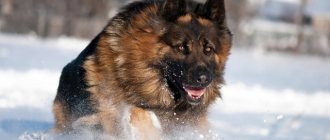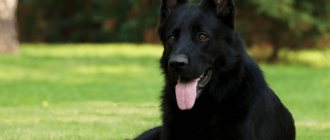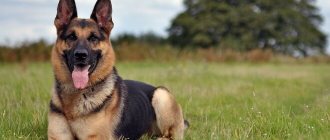Studying the stages of development of a breed is a mandatory step before getting a pet. The health, strength and agility of the dog directly depend on them.
The weight of a German Shepherd puppy, as well as its height, can be monitored according to the standards given in the table. They determine the correspondence between age and physical parameters.
This is interesting: Diet for German Shepherd puppies
Stages of development of the German Shepherd
The process of growing up is characterized by signs. After its completion, body growth stops, all physiological characteristics that are characteristic of the breed are fixed.
Basis - intrauterine development
The fetus begins to develop in the mother's womb. After conception, the formation of the central nervous system and external data occurs in the female body.
Fetal development is affected by:
- proper care and maintenance of a pregnant bitch;
- reasonable selection of a male for mating.
What do offspring inherit from their parents?
- temperament;
- food cravings;
- learning abilities;
- size of an adult dog;
- memory.
Expert opinion
Anna Abramenko
An avid dog lover. Experience in veterinary medicine since 2009.
Ask a Question
It is important not to confuse temperament and character. The dog will acquire the second in society - among relatives, next to a person, during training. A certain type of nervous system is transmitted to him from a bitch or dog.
Suction stage
Based on the name, it is clear that this period occurs while the mother feeds the puppies with milk for 4 to 8 weeks.
The development of children directly depends on the dog breeder; he must:
- provide adequate nutrition and care for the mother;
- do not tear off the offspring early from the breast, otherwise the puppies will not receive the proper amount of antibodies, which will affect the quality of health in the future.
Period of childhood and adolescence
During these periods, active growth of the German Shepherd occurs. At 2 months, she finds herself in a new home with her owner, and active socialization begins.
What happens at this stage:
- the puppy gradually changes and grows new teeth;
- he moves actively, due to his age he becomes curious, you can see individual traits of character and temperament;
- the shepherd dog is socialized;
- physiological indicators actively increase.
If in the first and second stages, the birth and development of a healthy puppy outside the womb depended on the genetic data of the parents and the proper care of the breeder for the mother, now the responsibility falls on the “leader” - the person.
What it provides:
- complete feeding;
- attention – the pet must develop in society. Without this, he will be nervous, which will have a bad effect on his character, learning ability, and physiological indicators;
- the beginning of the first training sessions;
- education without excessive rigidity;
- vaccinations.
The duration of the stage is from 2 to 6 months.
The puppy turns into a young dog
The duration of the period is from 6 to 12 months.
What is it characterized by:
- completion of bone formation;
- weight is gained through mass. The body grows “in breadth”;
- girls reach almost their full maximum height;
- Males from 6 to 10 months become capable of fertilization;
- The shepherd, in general, looks like an adult animal. But physical and psychological development is not yet completed.
Growing up period
The stages are divided into 2 points:
- Physical.
- Psychological.
Body development stops at about 1 year of age. Psychological formation is individual. It depends on the shepherd’s inherent temperament, acquired character, and patience of the owner. Some individuals mature at 2 years, while others only at 2.5 or 3.
The influence of various factors on the pet’s parameters
A variety of factors can influence a puppy's height and weight, such as:
- Heredity . Dogs of some lines grow larger, while others grow smaller in size. In addition, the rate of height and weight gain may also depend on heredity.
- Intrauterine development . If the puppy’s mother ate properly during pregnancy and was kept in good conditions, then her babies received all the vitamins and minerals they needed. They gained good weight and height at the time of birth, and therefore had all the makings for normal physical development.
- Sucking period . The conditions for keeping and feeding babies in the breeder’s home are very important. If the lactating bitch ate well, and the puppies were started on time and fed correctly, then by the time of activation and subsequent sale they will have good height and weight, and their psychological and physical development will be appropriate for their age.
- Quality of feeding. Often, lack of height or weight in dogs is due to the fact that the dog is malnourished, which is why it regularly does not get the vitamins, microelements and other nutrients it needs.
- Content. If a German Shepherd puppy is constantly sitting in an enclosure or on a chain and is not being handled, trained or walked, then it simply will not have the opportunity to develop physically. The same applies to city dogs, which are kept in apartments and taken outside only for a few minutes a day.
- Diseases. If a puppy or young dog has suffered from a serious infectious disease, its growth may be stunted or even stop completely. The presence of internal parasites can also negatively affect a dog’s height and weight.
In order for a shepherd puppy to grow up strong and healthy, so that it does not suffer from infections due to which it may subsequently stop growing, it is necessary to give it all the necessary vaccinations on time and protect it from contact with sick animals.
World class standards
They were compiled and approved by the German Shepherd Fanciers' Union in Augsburg (Germany), as they are considered the founders of the breed.
Main parameters:
- average height;
- dry bones;
- well developed muscles;
- the length of the entire body of an adult shepherd dog should be 10-17% greater than its height;
- height at withers – males 60-65, females – 55-60 cm (average weight);
- the nose should be black;
- ears are erect.
Weight and dimensions of a newborn puppy
On average, the weight of a newborn male is 500 g, females are born weighing from 350 g . But this is the average litter size of 6-8 puppies.
If a small number of shepherd puppies were born - 3-4, then their weight, regardless of gender, will be equal to 450-500 g. In a large litter, from 8 to 12 puppies, it, also regardless of the gender of the babies born, will be slightly smaller and will be approximately 350-450 g.
The length of newborn German Shepherd puppies is 18-22 cm.
Tips for the owner
- It is necessary to communicate with the puppy during the period of its socialization. He must feel the “leader” and be friends with members of the “pack” - people or other animals.
- The shepherd dog should not be prevented from exploring objects, places, or animals to gain skills. They will help develop the characteristic traits of the breed (tolerance, resistance to stress).
- The process of raising and training a puppy should begin from puppyhood.
- It is advisable to monitor the dog’s physiological indicators according to the norms. Minor deviations are possible.
- The animal must have 2 bowls (for food and water).
- It is necessary to be present with the dog when feeding.
The German Shepherd is a working breed of dog. Its distinctive features are balance, strength, and agility. And for the animal to show them in the future, the owner needs to study all stages of development, the norms of the puppy’s parameters and monitor his health.
Basic feeding rules
Experienced dog handlers claim that there is no general diet, proposing to take into account the calorie content, the composition, the vitamin complex, and even the character of the dog, coupled with the loads it faces..
At six months of age, the formation of muscle mass in a dog is in full swing; at this moment, it is especially important when preparing a diet to take into account the correct ratio of calories, proteins, fats and carbohydrates.
IMPORTANT!
The required daily food intake of an adult dog: 3−5% of its weight, which is approximately 1 kg 200 g.
General requirements when creating a menu:
- 1/3 part - raw meat (scalded, boiled); Once a week, instead of meat, you can give fish;
- 1/3 part - porridge (millet, rice or buckwheat);
- 1/3 part - vegetables and dairy products (if dairy products cause intestinal problems in your dog, you should avoid them and replace them with vegetables).
The period of maximum active growth of a shepherd dog lasts up to a year . At this point, the puppy must be fed intensively, taking into account the calcium and vitamin intake necessary for growth and development.
Natural food
When planning your dog’s diet, you should include the following foods in the menu::
- meat and offal (necessarily liver);
- milk ;
- dairy products;
- chicken eggs (raw, boiled);
- vegetables;
- sea fish (boiled);
- cereal porridge;
- greens, berries, fruits (in limited quantities).
Regardless of the type of food (dry or natural), the puppy must eat according to a certain pattern:
- 1-2 months - a glass of food, divided into 6 doses.
- 2-3 months - 1.5 glasses in 5 approaches.
- 3-6 months - 1 liter in 4 approaches.
- 6-12 months - 1.5 liters in 3 approaches.
At one year of age, the dog begins to eat according to an adult meal schedule - twice a day.
List of foods that are prohibited for a dog's diet:
- meat with a high fat content (pork, lamb);
- bones (chicken, fish, pork);
- pasta;
- potato dishes;
- sausages;
- any baked goods;
- legumes;
- smoked, fried or dried meat;
- all types of flour food;
- candies, chocolate;
- mushrooms;
- fish (raw, river);
- pickled and canned vegetables;
- all types of canned food;
- semolina, millet and pearl barley;
- citrus fruits;
- raw milk;
- spicy dishes containing spices.
Dry food
When choosing dry food for your pet, the owner of a shepherd dog needs to pay attention to the following aspects:
- products must be branded, and not just released under license;
- high-quality food will not have a bright, saturated color (red or green);
- the composition should not contain soy and legumes (cereals are allowed);
- Puppies and pregnant women should not be given pellets with a high fat content;
- The amount of protein in the feed should be from 30 to 50%.
It would be optimal to buy food in a sealed package (from the factory).
When feeding your dog dry food, you should buy only premium and super premium brands. Economy class is not recommended for German Shepherds.
You also need to remember that food of the best quality and class can only be purchased in specialized stores and veterinary pharmacies. They are made from excellent quality products.
Popular manufacturers of the highest class food for German Shepherd dogs:
- Dukes Farm;
- Bosch;
- Eukanuba;
- Arden Grange.
Daily norm when feeding a shepherd dog with dry food:
- premium class - about 750 g,
- super premium class - 600 g.
If necessary, you can soak the granules with water or kefir (if the dog is reluctant to eat dry food) . The pet must also have round-the-clock access to drinking water.
Weight table by month
Summarizing the above data, we will draw up a weight table for each period of life of a given breed:
| Period of time | Male body weight | Body weight of females |
| 1 month | 3.5 – 4.2 kg | 3 – 3.3 kg |
| 2 months | 8.5 – 9 kg | 7.5 – 8 kg |
| 3 months | 14 – 14.2 kg | 12 – 12.3 kg |
| 4 months | 19 – 20 kg | 16 – 16.4 kg |
| 5 months | 22 – 22.9 kg | 20 – 21.7 kg |
| 6 months | 24 - 26 kg | 22.5 – 23 kg |
| 8 months | 29 – 30 kg | 25 – 25.2 kg |
| 10 months | 32.9 – 33.3 kg | 27 – 27.5 kg |
| 1 year | 33 – 34 kg | 30 – 32 kg |
| 1.5 year | 34.5 – 35 kg | 32.5 – 33 kg |
| 2 years | 35.5 – 36 kg | 33.3 – 34 kg |
| 3 years | 36.5 – 40 kg | 34.5 – 35 kg |
In conclusion, I would like to say that if a pet does not meet its weight parameters when it is under 3 years of age, this is not a cause for concern. After all, all animals grow differently, and weight loss can reach up to 15 percent. If, even after 3 years, the dog does not gain weight or, on the contrary, has more weight than necessary, you should contact a veterinarian to prescribe treatment. After all, an animal that has a deviation in body weight of at least 1 kg is considered defective by dog handlers and is not allowed for exhibitions.











